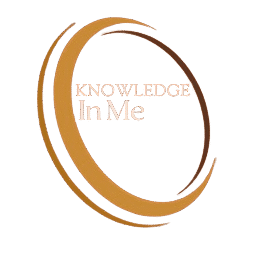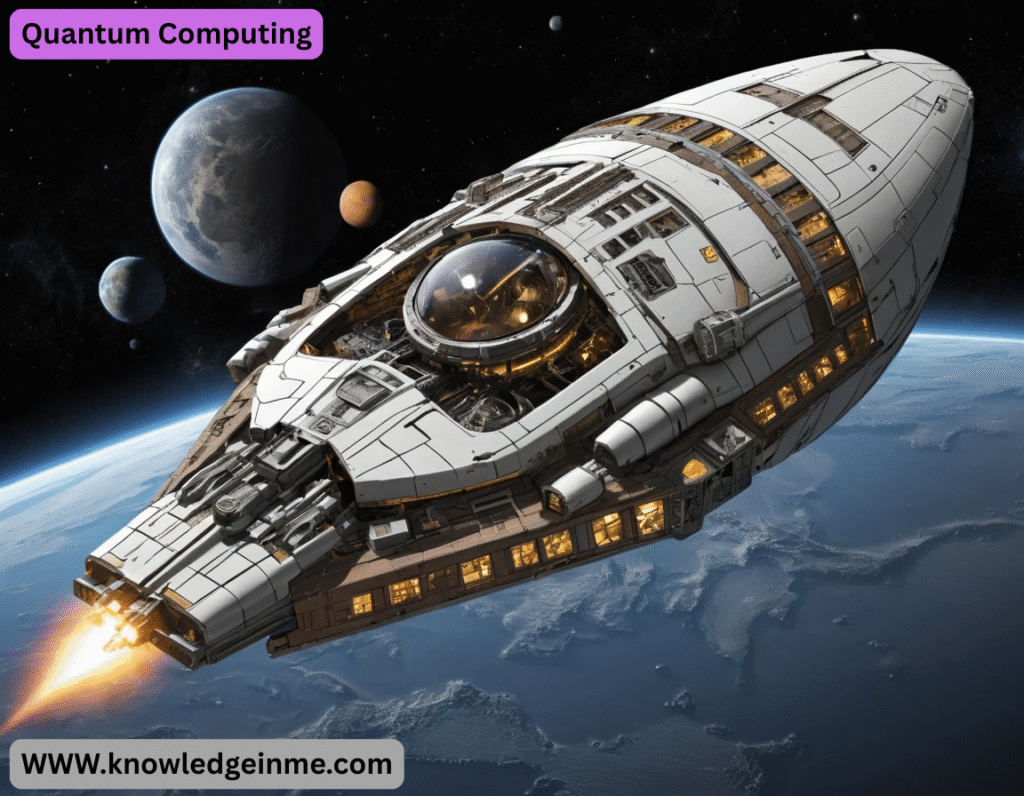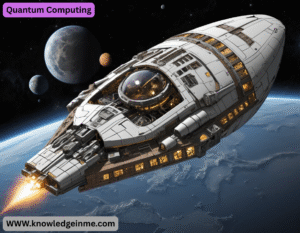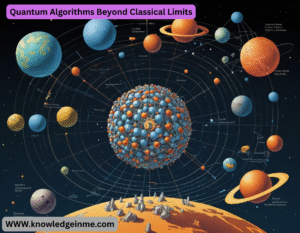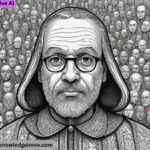Quantum Computing Quantum computing is an emerging field that leverages the principles of quantum mechanics to perform computations far more efficiently than classical computers for certain problems. Unlike classical bits (which are either 0 or 1), quantum computers use quantum bits (qubits), which can exist in a superposition of states, enabling parallel processing.
Key Concepts in Quantum Computing
- Qubits (Quantum Bits)
- Can be 0, 1, or both simultaneously (superposition).
- Measured in a probabilistic manner (collapsing to 0 or 1 upon measurement).
Superposition
Quantum Gates & Circuits
- Analogous to classical logic gates but operate on qubits (e.g., Hadamard gate, CNOT gate).
- Enable quantum algorithms like Shor’s algorithm (factoring) and Grover’s algorithm (search).
- Quantum Decoherence & Error Correction
Potential Applications
- Cryptography: Breaking RSA encryption (Shor’s algorithm).
- Optimization: Solving complex logistics and financial modeling.
- Drug Discovery: Simulating molecular interactions efficiently.
- AI & Machine Learning: Faster training of models (quantum machine learning).
- Material Science: Designing new superconductors and materials.
Challenges
- Hardware Limitations: Qubits are error-prone and require extreme cooling (near absolute zero).
- Scalability: Current quantum computers have <1000 qubits (Google’s 72-qubit Sycamore, IBM’s 433-qubit Osprey).
- Error Rates: High noise levels necessitate error correction, increasing qubit overhead.
Current State (2024)
- Noisy Intermediate-Scale Quantum (NISQ) Era:
- Quantum computers are not yet fault-tolerant.
- Hybrid quantum-classical algorithms (e.g., VQE) are being explored.
Major Players:
- IBM (Quantum Experience, Qiskit)
- Google (Sycamore, Quantum AI)
- Rigetti, IonQ, D-Wave (quantum annealing)
- Microsoft (Topological qubits, Azure Quantum)
Future Outlook
- Fault-Tolerant Quantum Computing: Requires millions of error-corrected qubits (likely >10 years away).
- Quantum Advantage: Demonstrated in specific tasks (e.g., Google’s 2019 quantum supremacy experiment), but practical applications remain limited.
Quantum Algorithms: Beyond Classical Limits
- Quantum algorithms exploit superposition, entanglement, and interference to solve problems faster than classical computers.
- A. Shor’s Algorithm (Factoring & Cryptography)
How it works:
- Uses Quantum Fourier Transform (QFT) to find the period of a function.
- Reduces factoring to a period-finding problem.
- Impact: Threatens current public-key cryptography (post-quantum cryptography is being developed).
B. Grover’s Algorithm (Search & Optimization)
- Purpose: Searches an unsorted database in
Applications:
- Accelerating brute-force attacks (halving encryption key search time).
- Optimization in machine learning and logistics.
C. Quantum Simulation (Chemistry & Materials)
- Purpose: Simulates quantum systems (e.g., molecules) efficiently.
Algorithms:
- VQE (Variational Quantum Eigensolver): Hybrid quantum-classical method for finding molecular ground states.
- QAOA (Quantum Approximate Optimization Algorithm): Solves combinatorial optimization problems.
D. HHL Algorithm (Linear Algebra Speedup)
- Purpose: Solves linear systems exponentially faster (useful in AI, economics, engineering).
- Limitation: Requires error correction (not feasible on NISQ devices yet).
2. Quantum Hardware: How Qubits Are Built
Different technologies compete to build stable, scalable qubits:
Qubit Type Key Players Pros Cons
Superconducting IBM, Google, RIGETTI Fast gates, scalable Requires near-absolute-zero temps
Trapped Ions IONQ, Honeywell Low error rates, long coherence Slower operations
Topological Microsoft (StationQ) Error-resistant (theoretically) Still in research phase
Photonic Xanadu, PsiQuantum Room-temperature operation Hard to entangle at scale
Silicon Spin Intel Leverages semiconductor tech Low coherence times
Current Best: Trapped ions (IONQ) lead in low error rates, while superconducting (IBM/Google) lead in scalability.
3. Key Challenges in Quantum Computing
A. Decoherence & Noise
- Qubits lose their state quickly due to heat, electromagnetic interference, etc.
Solutions:
- Error Correction: Surface codes, but require ~1000 physical qubits per logical qubit.
- Better Materials: Topological qubits (Microsoft) or improved superconductors.
B. Scalability
- Current quantum processors have 50–1000 qubits (e.g., IBM’s 433-qubit Osprey).
C. Cooling & Control
- Superconducting qubits require near-absolute-zero temperatures (~15 MK).
- Trapped ions need ultra-high vacuum and laser precision.
D. Software & Algorithms
- Most algorithms (e.g., Shor’s) need error correction (not yet practical).
- Hybrid quantum-classical approaches (e.g., VQE) are bridging the gap. Logical qubits with error correction (~1000 physical qubits per logical qubit).
5. The Future Roadmap
Short-Term (Next 5 Years)
- NISQ (Noisy Intermediate-Scale Quantum):
- Hybrid quantum-classical algorithms (VQE, QAOA).
- Small-scale optimizations (finance, logistics).
Improved Qubit Fidelity:
- Error mitigation techniques (zero-noise extrapolation).
- Mid-Term (5–10 Years)
- Early Fault Tolerance:
Industry Applications:
- Quantum machine learning, drug discovery, materials design.
Long-Term (10+ Years)
Full Fault-Tolerant QC:
- Millions of qubits running Shor’s, HHL, etc.
Quantum Internet:
- Secure communication via quantum key distribution (QKD).
6. How to Get Started in Quantum Computing
A. Learn the Basics
- Math Prerequisites: Linear algebra, probability, complex numbers.
Books:
- Quantum Computation and Quantum Information (Nielsen & Chuang) – The “bible” of QC.
- Quantum Computing for Everyone (Chris Bernhardt) – Beginner-friendly.
B. Hands-On Coding
Frameworks:
- Qiskit (IBM, Python) – Best for beginners.
- Cirq (Google) – Focused on near-term algorithms.
- Penny Lane (Xanadu) – Quantum machine learning.
Cloud Access:
IBM Quantum Experience, Amazon Braket, Microsoft Azure Quantum.
C. Research & Careers
Fields:
- Quantum algorithms, error correction, hardware design.
Companies Hiring:
- IBM, Google, LONQ, RIGETTI, startups (Psi Quantum, Quan tINUUM).
- Quantum Error Correction (QEC): The Path to Fault Tolerance
- Without error correction, quantum computations fail due to decoherence and noise. Here’s how QEC works:
A. The Threshold Theorem
- Claim: If error rates are below a certain threshold (~1 error per 1,000 operations), errors can be suppressed arbitrarily.
Requirements:
- Physical qubits → Logical qubits: Encode 1 logical qubit in many physical qubits (e.g., surface code needs ~1,000 physical qubits per logical qubit).
- Fault-tolerant gates: Operations must not spread errors.
B. Surface Code (Best Near-Term Approach)
How it works:
- Qubits are arranged in a 2D lattice.
- Stabilizer measurements detect errors without collapsing the state.
- Errors appear as “ANYONS” (quasiparticles), which can be tracked and corrected.
- Overhead: ~1,000 physical qubits per logical qubit (IBM aims for 1 million qubits by 2033 for practical QEC).
C. Alternatives to Surface Code
Code Key Advantage Challenge
Color Code Better fault tolerance More complex
LDPC Codes Lower overhead (~100 phys. per log.) Requires long-range connectivity
Topological Natural error resistance (Microsoft) Still theoretical
D. Error Mitigation (For NISQ Era)
- Since full QEC is years away, researchers use:
- Zero-Noise Extrapolation: Run circuits at different noise levels and extrapolate to zero noise.
- Probabilistic Error Cancellation: Use classical post-processing to cancel noise effects.
2. Quantum Hardware: Physics of Qubit Technologies
- Let’s dissect how different qubits actually work at the physical level.
- A. Superconducting Qubits (TRANSMON Qubits)
How it works:
- A Josephson junction acts as a nonlinear inductor, creating quantized energy levels.
- Microwave pulses manipulate states (e.g., IBM’s cross-resonance gate).
- Cooling Needed: ~10 mK (dilution refrigerators).
B. Trapped Ion Qubits
How it works:
- Ions (e.g., Ytterbium) are suspended in a vacuum using electric fields.
- Lasers perform gates via phonon-mediated interactions.
Pros:
- Long coherence times (seconds vs. microseconds in superconductors).
- High-fidelity gates (99.9%+).
C. Topological Qubits (MAJORANA Fermions)
Microsoft’s Bet:
- Quasiparticles in superconducting nanowires are naturally error-resistant.
- Braiding them performs quantum gates (like knots in spacetime).
- Status: Still no definitive experimental proof (but progress in 2023).
D. Photonic Qubits (Linear Optical QC)
How it works:
- Qubits encoded in photon polarization or path.
- Gates performed using beam splitters and phase shifters.
- Challenge: No deterministic entanglement (solved using fusion gates in PSIQUANTUM’s approach).
